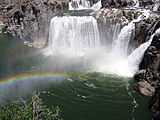Shoshone Falls
| Shoshone Falls | |
|---|---|
 Shoshone Falls in March 2011 | |
 | |
| Location | Twin Falls Co., Idaho, U.S. |
| Coordinates | 42°35′42″N 114°24′00″W / 42.595°N 114.400°WCoordinates: 42°35′42″N 114°24′00″W / 42.595°N 114.400°W |
| Type | Block |
| Elevation | 3,355 ft (1,023 m) |
| Total height | 212 ft (65 m) |
| Number of drops | 1 |
| Total width | 1,000 ft (300 m) |
| Watercourse | Snake River |
| Average flow rate | 3,578 cu ft/s (101.3 m3/s) |
Shoshone Falls (/ʃoʊˈʃoʊn/) is a waterfall on the Snake River in southern Idaho, located approximately five miles (8 km) east of the city of Twin Falls. Sometimes called the "Niagara of the West," Shoshone Falls is 212 feet (65 m) high—45 feet (14 m) higher than Niagara Falls—and flows over a rim 1,000 feet (300 m) wide.
A park overlooking the waterfall is owned and operated by the City of Twin Falls. Shoshone Falls is best viewed in the spring, as diversion of the Snake River for irrigation often significantly diminishes water levels in the summer and fall.
Daredevil Evel Knievel attempted to jump the Snake River Canyon in 1974; the launch site for his Skycycle X-2 is less than two miles (3 km) west of the falls, on the south rim of the canyon (42°35′49″N 114°25′23″W / 42.597°N 114.423°W).
History

Shoshone Falls has existed at least since the end of the last ice age, when the Bonneville Flood carved much of the Snake River canyon and surrounding valleys. It is a total barrier to the upstream movement of fish. The falls were the upper limit of sturgeon, and spawning runs of salmon and steelhead could not pass the falls. Yellowstone cutthroat trout lived above the falls in the same ecological niche as Rainbow Trout below it. Due to this marked difference, the World Wide Fund for Nature used Shoshone Falls as the boundary between the Upper Snake and the Columbia Unglaciated freshwater ecoregions.
Ecology
Prior to the construction of the many dams on the Snake River below the falls, there were tremendous runs of salmon in the Snake River. The salmon fishery at the base of the falls was a primary food source for Bannock and Shoshone Indians. An 1843 expedition claimed that during the springtime runs, spears could be thrown into the water at random and consistently strike salmon.[1]
Only 35% of fish species of the upper Snake River are shared with the lower Snake and Columbia rivers. Fourteen fish species found in the upper Snake are also found in the Bonneville freshwater ecoregion (which covers the Great Basin portion of Utah), but not the lower Snake or Columbia rivers. The upper Snake River is also high in freshwater mollusk endemism (such as snails and clams).[2]
Images
-

Early photo of Shoshone Canyon and Falls, Idaho Territory. A member of Clarence King's Geological Exploration of the Fortieth Parallel is surveying from a rock. (Timothy H. O'Sullivan, 1868)[1]
-

Shoshone Falls (May 1998)
-

Shoshone Falls (July 2006)
-
.jpg)
Photochrom of Shoshone Falls ca. 1898
-
Shoshone Falls viewed from the northwest
Cite error: There are <ref> tags on this page, but the references will not show without a {{reflist}} template (see the help page).
See also
Notes
- ↑ Report John C. Fremont Expedition of 1843.
- ↑ Abell, Robin A., David M. Olson, Eric Dinerstein, Patrick T. Hurley et al. (WWF) (2000). Freshwater Ecoregions of North America: a conservation assessment. Island Press. ISBN 1-55963-734-X
External links
| Wikimedia Commons has media related to Shoshone Falls. |
- U.S. Geological Survey Geographic Names Information System: Shoshone Falls. Retrieved 2008-05-03.
